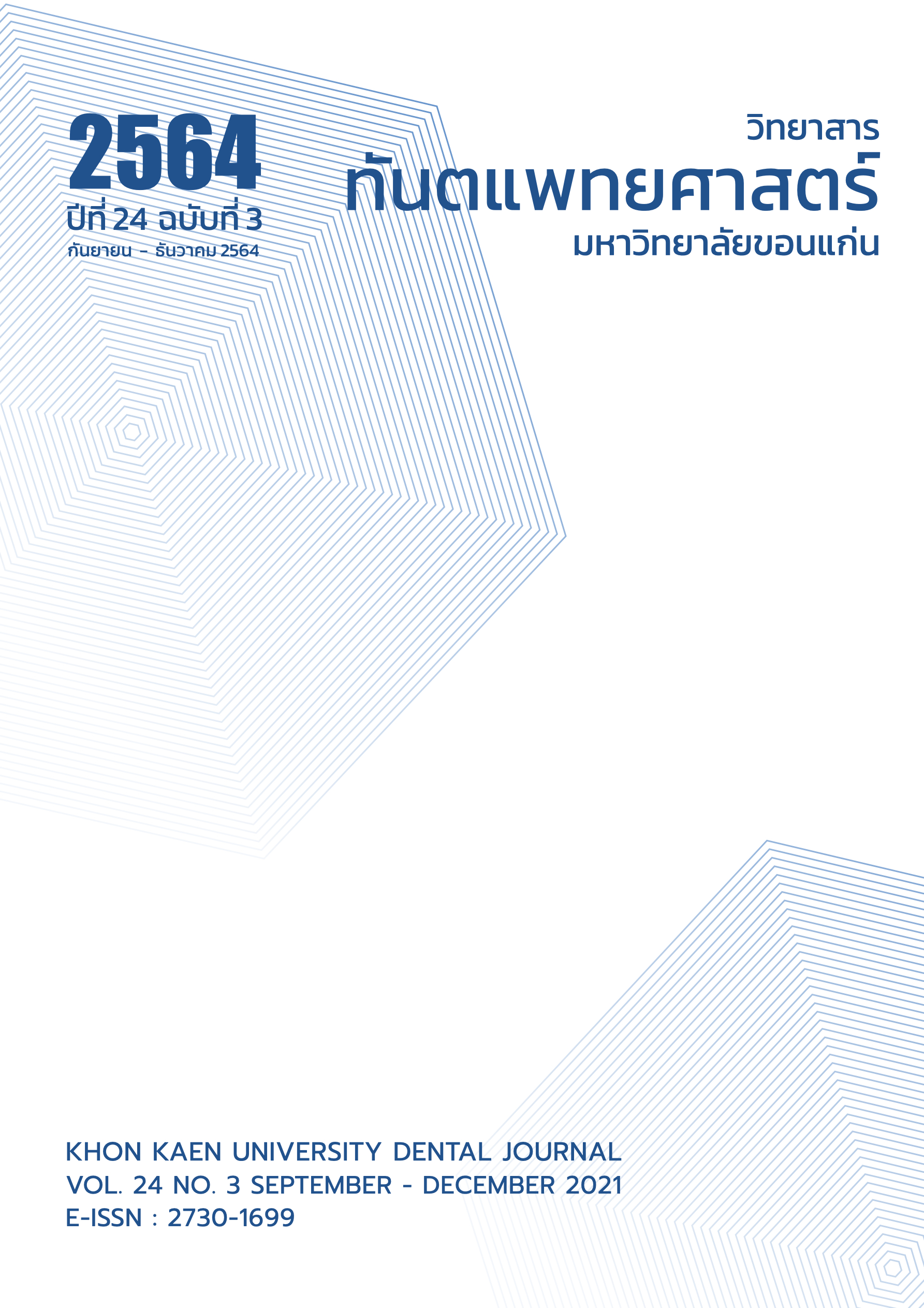การเปรียบเทียบพื้นที่ฟองอากาศในการผสมวัสดุพิมพ์ปากอัลจิเนต ระหว่างกลุ่มที่ฝึกด้วยวัสดุพิมพ์ปากอัลจิเนตกับกลุ่มที่ฝึกผสมด้วยอัลจิเนตเทียม
Main Article Content
บทคัดย่อ
ผู้วิจัยได้พัฒนาอัลจิเนตเทียมซึ่งมีราคาถูกขึ้นจากดินเบาและแป้งข้าวเหนียวเพื่อให้นักศึกษาทันตแพทย์ใช้ทดแทนการฝึกผสมวัสดุพิมพ์ปากอัลจิเนตด้วยมือที่ใช้ในคลินิก การฝึกผสมเป็นทักษะเฉพาะเพื่อให้ได้คุณภาพของรอยพิมพ์ที่ดี การศึกษานี้จึงมีวัตถุประสงค์เพื่อเปรียบเทียบความสามารถของนักศึกษาในการผสมอัลจิเนตระหว่างกลุ่มที่ฝึกผสมด้วยอัลจิเนตกับกลุ่มที่ฝึกผสมด้วยอัลจิเนตเทียมโดยพิจารณาจากพื้นที่ฟองอากาศที่หน้าตัดของชิ้นทดสอบอัลจิเนต กลุ่มตัวอย่างของการวิจัยคือ นักศึกษาทันตแพทย์ชั้นปีที่ 1 คณะทันตแพทยศาสตร์ มหาวิทยาลัยขอนแก่น จำนวน 40 คน ซึ่งยังไม่เคยเรียนรู้และฝึกผสมวัสดุพิมพ์ปากอัลจิเนตมาก่อน โดยเริ่มจากให้ความรู้แก่กลุ่มตัวอย่างเกี่ยวกับการผสมอัลจิเนตผ่านสื่อการสอนวีดิทัศน์ แล้วแบ่งกลุ่มตัวอย่างออกเป็น 2 กลุ่ม คือกลุ่มที่ฝึกผสมด้วยอัลจิเนตและอัลจิเนตเทียม กลุ่มละ 20 คน ทำการทดสอบคุณภาพการผสมอัลจิเนตทั้งก่อนและหลังการฝึกผสม โดยพิจารณาพื้นที่ฟองอากาศที่หน้าตัดของชิ้นทดสอบอัลจิเนต จากผลการทดลองพบว่ากลุ่มที่ฝึกผสมด้วยอัลจิเนตมีค่าการกระจายข้อมูลไม่ปกติ จึงใช้สถิติไม่อิงพารามิเตอร์เพื่อเปรียบเทียบค่ามัธยฐาน ซึ่งค่ามัธยฐานของผลต่างในกลุ่มอัลจิเนตมีค่าเท่ากับ 5.3 ตารางมิลลิเมตร มีค่าพิสัยควอร์ไทล์เท่ากับ -2.0 ถึง 15.9 ตารางมิลลิเมตร สำหรับกลุ่มอัลจิเนตเทียมมีค่าเท่ากับ 5.5 ตารางมิลลิเมตรและค่าพิสัยควอร์ไทล์เท่ากับ -3.9 ถึง 19.5 ตารางมิลลิเมตร ทดสอบสมมติฐานโดยใช้สถิติแมนวิทนี ยูเทสท์ (Mann-Whitney U test) พบว่า ค่ามัธยฐานของผลต่างของพื้นที่ฟองอากาศที่หน้าตัดของชิ้นทดสอบอัลจิเนตในกลุ่มอัลจิเนตกับกลุ่มอัลจิเนตเทียมแตกต่างกันอย่างไม่มีนัยสำคัญทางสถิติ (p=0.96) ดังนั้นการฝึกผสมด้วยอัลจิเนตเทียมก่อให้เกิดทักษะในการผสมวัสดุพิมพ์ปากได้ไม่แตกต่างจากการฝึกผสมด้วยอัลจิเนต
Article Details
บทความ ข้อมูล เนื้อหา รูปภาพ ฯลฯ ทีได้รับการลงตีพิมพ์ในวิทยาสารทันตแพทยศาสตร์ มหาวิทยาลัยขอนแก่นถือเป็นลิขสิทธิ์เฉพาะของคณะทันตแพทยศาสตร์ มหาวิทยาลัยขอนแก่น หากบุคคลหรือหน่วยงานใดต้องการนำทั้งหมดหรือส่วนหนึ่งส่วนใดไปเผยแพร่ต่อหรือเพื่อกระทำการใด ๆ จะต้องได้รับอนุญาตเป็นลายลักษณ์อักษร จากคณะทันตแพทยศาสตร์ มหาวิทยาลัยขอนแก่นก่อนเท่านั้น
References
Arwatchanakan S, Rattanakanokchai K, Luengpailin S, Saikaew C, Sooksuntisakoonchai N. Effect of hand mixing and automatic machine mixing of alginate impression material of the existence of air bubbles and mechanical properties. Khon Kaen Dent J 2012;15(1):29-41.
Arwatchanakan S, Wiboonpin T, Luengpailin S, Sooksuntisakoonchai N, Arwatchanagarn M, Hovichitr W. The existence of air bubbles and mechanical properties of alginate impression material mixed by hand mixing, automatic machine invented automatic machine prototype 1 and 2. Khon Kaen Dent J 2014;17(2):133-43.
Powers JM, Wataha JC. Dental Materials: Properties and Manipulation. 10thed. St.Louis: Mosby Elsevier; 2013. 172-85.
Oermann MH, De Gagne JC, Phillips BC. Teaching in Nursing and Role of the Educator, 2nd ed.: The Complete Guide to Best Practice in Teaching, Evaluation, and Curriculum Development. Vol Second edition. New York, NY: Springer Publishing Company; 2018.47-74.
Kaewkumnerd K. Production of diatomaceous earth filter media in industrial filtration: research report. Chiang Mai: Science and Technology Service Center, Faculty of Science Chiang Mai University; 1992.
Atthaaroon C. Survey and research of Properties of Lampang diatomaceous earth for environmental work. Bangkok, Mineral Resources Analysis and Identification Division Department of Mineral Resources; 2001.24-9.
Inoue K, Song YX, Fujii K, Kadokawa A, Kanie T. Consistency of alginate impression materials and their evaluation. J Oral Rehabil 1999;26(3):203-7.
Guiraldo RD, Berger SB, Consani RL, Consani S, de Carvalho RV, Lopes MB, et al. Characterization of morphology and composition of inorganic fillers in dental alginates. Biomed Res Int 2014;24:1-6.
Nattrass C, Horwell CJ, Damby DE, Kermanizadeh A, Brown DM, Stone V. The global variability of diatomaceous earth toxicity: a physicochemical and in vitro investigation. J Occup Med Toxicol 2015;10:23-39.
Prajummueng P, Leelawatcharamart W. Starch digestive enzymes. J Acad Ser KKU 2003;11(4):28-31.
Satang N, Srijessadaruk V, Nantachai K, Voraputhaporn W. Acetylation and Cross-link Modification of Waxy Rice Starch to be used as Thickening Agent. KKU Res J 2002;2(2):1-5.
Reisbick MH, Garrett R, Smith DD. Some effects of device versus hand mixing of irreversible hydrocolloids. J Prosthet Dent 1982;47(1):92-4.
American dental association. American Dental Association Specification No. 18 Alginate Impression Materials. United States: American Dental Association;1992.

